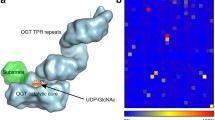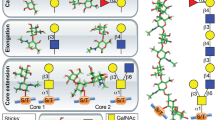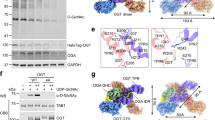Abstract
O-GlcNAc transferase (OGT) is an essential enzyme that installs O-linked N-acetylglucosamine (O-GlcNAc) to thousands of protein substrates. OGT and its isoforms select from these substrates through the tetratricopeptide repeat (TPR) domain, yet the impact of truncations to the TPR domain on substrate and glycosite selection is unresolved. Here, we report the effects of iterative truncations to the TPR domain of OGT on substrate and glycosite selection with the model protein GFP-JunB and the surrounding O-GlcNAc proteome in U2OS cells. Iterative truncation of the TPR domain of OGT maintains glycosyltransferase activity but alters subcellular localization of OGT in cells. The glycoproteome and glycosites modified by four OGT TPR isoforms were examined on the whole proteome and a single target protein, GFP-JunB. We found the greatest changes in O-GlcNAc on proteins associated with mRNA splicing processes and that the first four TPRs of the canonical nucleocytoplasmic OGT had the broadest substrate scope. Subsequent glycosite analysis revealed that alteration to the last four TPRs corresponded to the greatest shift in the resulting O-GlcNAc consensus sequence. This dataset provides a foundation to analyze how perturbations to the TPR domain and expression of OGT isoforms affect the glycosylation of substrates, which will be critical for future efforts in protein engineering of OGT, the biology of OGT isoforms, and diseases associated with the TPR domain of OGT.
Graphical abstract







Similar content being viewed by others
Data availability
The MS data were deposited at the ProteomeXchange Consortium [57] via the PRIDE partner repository, and are available with the identifier PXD028141.
References
Wulff-Fuentes E, Berendt RR, Massman L, Danner L, Malard F, Vora J, Kahsay R, Olivier-Van Stichelen S. The human O-GlcNAcome database and meta-analysis. Sci Data. 2021;8:25. https://doi.org/10.1038/s41597-021-00810-4.
Joiner CM, Li H, Jiang J, Walker S. Structural characterization of the O-GlcNAc cycling enzymes: insights into substrate recognition and catalytic mechanisms. Curr Opin Struct Biol. 2019;56:97–106. https://doi.org/10.1016/j.sbi.2018.12.003.
Stephen HM, Adams TM, Wells L. Regulating the regulators: mechanisms of substrate selection of the O-GlcNAc cycling enzymes OGT and OGA. Glycobiology. 2021;1–5. https://doi.org/10.1093/glycob/cwab005.
Shafi R, Iyer SP, Ellies LG, O’Donnell N, Marek KW, Chui D, Hart GW, Marth JD. The O-GlcNAc transferase gene resides on the X chromosome and is essential for embryonic stem cell viability and mouse ontogeny. Proc Natl Acad Sci U S A. 2000;97:5735–9. https://doi.org/10.1073/pnas.100471497.
Yang YR, Song M, Lee H, Jeon Y, Choi EJ, Jang HJ, Moon HY, Byun HY, Kim EK, Kim DH, Lee MN, Koh A, Ghim J, Choi JH, Lee-Kwon W, Kim KT, Ryu SH, Suh PG. O-GlcNAcase is essential for embryonic development and maintenance of genomic stability. Aging Cell. 2012;11:439–48. https://doi.org/10.1111/j.1474-9726.2012.00801.x.
Pravata VM, Omelková M, Stavridis MP, Desbiens CM, Stephen HM, Lefeber DJ, Gecz J, Gundogdu M, Õunap K, Joss S, Schwartz CE, Wells L, van Aalten DMF. An intellectual disability syndrome with single-nucleotide variants in O-GlcNAc transferase. Eur J Hum Genet. 2020;28:706–14. https://doi.org/10.1038/s41431-020-0589-9.
Yuzwa SA, Vocadlo DJ. O-GlcNAc and neurodegeneration: biochemical mechanisms and potential roles in Alzheimer’s disease and beyond. Chem Soc Rev. 2014;43:6839–58. https://doi.org/10.1039/c4cs00038b.
Ma J, Hart GW. Protein O-GlcNAcylation in diabetes and diabetic complications. Expert Rev Proteomics. 2013;10:365–80. https://doi.org/10.1586/14789450.2013.820536.
Slawson C, Hart GW. O-GlcNAc signalling: implications for cancer cell biology. Nat Rev Cancer. 2011;11:678–84. https://doi.org/10.1038/nrc3114.
Levine ZG, Pottera SC, Joinerb CM, Feia GQ, Nabetc B, Sonnette M, Zacharaf NE, Grayc NS, Paulog JA, Walkera S (2021) Mammalian cell proliferation requires noncatalytic functions of O-GlcNAc transferase. Proc Natl Acad Sci U S A 118:2020.10.22.351288 . https://doi.org/10.1073/PNAS.2016778118
Joiner CM, Hammel FA, Janetzko J, Walker S. Protein substrates engage the lumen of O-GlcNAc transferase’s tetratricopeptide repeat domain in different ways. Biochemistry. 2021. https://doi.org/10.1021/acs.biochem.0c00981.
Kositzke A, Fan D, Wang A, Li H, Worth M, Jiang J. Elucidating the protein substrate recognition of O-GlcNAc transferase (OGT) toward O-GlcNAcase (OGA) using a GlcNAc electrophilic probe. Int J Biol Macromol. 2021;169:51–9. https://doi.org/10.1016/j.ijbiomac.2020.12.078.
Kreppel LK, Hart GW. Regulation of a cytosolic and nuclear O-GlcNAc transferase. Role of the tetratricopeptide repeats. J Biol Chem. 1999;274:32015–22. https://doi.org/10.1074/jbc.274.45.32015.
Lubas WA, Hanover JA. Functional expression of O-linked GlcNAc transferase. J Biol Chem. 2000;275:10983–8.
Iyer SPN, Hart GW. Roles of the tetratricopeptide repeat domain in O-GlcNAc transferase targeting and protein substrate specificity. J Biol Chem. 2003;278:24608–16. https://doi.org/10.1074/jbc.M300036200.
Hanover JA, Yu S, Lubas WB, Shin SH, Ragano-Caracciola M, Kochran J, Love DC. Mitochondrial and nucleocytoplasmic isoforms of O-linked GlcNAc transferase encoded by a single mammalian gene. Arch Biochem Biophys. 2003;409:287–97. https://doi.org/10.1016/S0003-9861(02)00578-7.
Love DC. Mitochondrial and nucleocytoplasmic targeting of O-linked GlcNAc transferase. J Cell Sci. 2002;116:647–54. https://doi.org/10.1242/jcs.00246.
Lazarus BD, Love DC, Hanover JA (2006) Recombinant O-GlcNAc transferase isoforms : identification of O-GlcNAcase , yes tyrosine kinase, and tau as isoform-specific substrates. 16:415–421 . https://doi.org/10.1093/glycob/cwj078
Zhang Q, Liu X, Gao W, Li P, Hou J, Li J, Wong J. Differential regulation of the ten-eleven translocation (TET) family of dioxygenases by O-linked β-N-acetylglucosamine transferase (OGT). J Biol Chem. 2014;289:5986–96. https://doi.org/10.1074/jbc.M113.524140.
Martinez M, Renuse S, Kreimer S, O’Meally R, Natov P, Madugundu AK, Nirujogi RS, Tahir R, Cole R, Pandey A, Zachara NE. Quantitative proteomics reveals that the OGT interactome is remodeled in response to oxidative stress. Mol Cell Proteomics. 2021;20: 100069. https://doi.org/10.1016/j.mcpro.2021.100069.
Gao J, Yang Y, Qiu R, Zhang K, Teng X, Liu R, Wang Y. Proteomic analysis of the OGT interactome: novel links to epithelial-mesenchymal transition and metastasis of cervical cancer. Carcinogenesis. 2018;39:1222–34. https://doi.org/10.1093/carcin/bgy097.
Deng RP, He X, Guo SJ, Liu WF, Tao Y, Tao SC. Global identification of O-GlcNAc transferase (OGT) interactors by a human proteome microarray and the construction of an OGT interactome. Proteomics. 2014;14:1020–30. https://doi.org/10.1002/pmic.201300144.
Ortiz-Meoz RF, Merbl Y, Kirschner MW, Walker S. Microarray discovery of new OGT substrates: the medulloblastoma oncogene OTX2 is O-GlcNAcylated. J Am Chem Soc. 2014;136:4845–8. https://doi.org/10.1021/ja500451w.
Stephen HM, Praissman JL, Wells L. Generation of an interactome for the tetratricopeptide repeat domain of O-GlcNAc transferase indicates a role for the enzyme in intellectual disability. J Proteome Res. 2021;20:1229–42. https://doi.org/10.1021/acs.jproteome.0c00604.
Tseng TS, Swain SM, Olszewski NE. Ectopic expression of the tetratricopeptide repeat domain of SPINDLY causes defects in gibberellin response. Plant Physiol. 2001;126:1250–8. https://doi.org/10.1104/pp.126.3.1250.
Izhaki A, Swain SM, Tseng TS, Borochov A, Olszewski NE, Weiss D. The role of SPY and its TPR domain in the regulation of gibberellin action throughout the life cycle of Petunia hybrida plants. Plant J. 2001;28:181–90. https://doi.org/10.1046/j.1365-313X.2001.01144.x.
Vaidyanathan K, Niranjan T, Selvan N, Teo CF, May M, Patel S, Weatherly B, Skinner C, Opitz J, Carey J, Viskochil D, Gecz J, Shaw M, Peng Y, Alexov E, Wang T, Schwartz C, Wells L. Identification and characterization of a missense mutation in the O-linked β-N-acetylglucosamine (O-GlcNAc) transferase gene that segregates with X-linked intellectual disability. J Biol Chem. 2017;292:8948–63. https://doi.org/10.1074/jbc.M116.771030.
Selvan N, George S, Serajee FJ, Shaw M, Hobson L, Kalscheuer V, Prasad N, Levy SE, Taylor J, Aftimos S, Schwartz CE, Huq AM, Gecz J, Wells L. O-GlcNAc transferase missense mutations linked to X-linked intellectual disability deregulate genes involved in cell fate determination and signaling. J Biol Chem. 2018;293:10810–24. https://doi.org/10.1074/jbc.RA118.002583.
Willems AP, Gundogdu M, Kempers MJE, Giltay JC, Pfundt R, Elferink M, Loza BF, Fuijkschot J, Ferenbach AT, Van Gassen KLI, Van Aalten DMF, Lefeber DJ. Mutations in N-acetylglucosamine (O-GlcNAc) transferase in patients with X-linked intellectual disability. J Biol Chem. 2017;292. https://doi.org/10.1074/jbc.M117.790097.
Gundogdu M, Llabrés S, Gorelik A, Ferenbach AT, Zachariae U, van Aalten DMF. The O-GlcNAc transferase intellectual disability mutation L254F distorts the TPR helix. Cell Chem Biol. 2018;1–6. https://doi.org/10.1016/j.chembiol.2018.03.004.
Liu L, Li L, Ma C, Shi Y, Liu C, Xiao Z, Zhang Y, Tian F, Gao Y, Zhang J, Ying W, Wang PG, Zhang L. O-GlcNAcylation of Thr12/Ser56 in short-form O-GlcNAc transferase (sOGT) regulates its substrate selectivity. J Biol Chem. 2019;294:16620–33. https://doi.org/10.1074/jbc.RA119.009085.
Feng Z, Hui Y, Ling L, Xiaoyan L, Yuqiu W, Peng W, Lianwen Z. FBXW10 is negatively regulated in transcription and expression level by protein O-GlcNAcylation. Biochem Biophys Res Commun. 2013;438:427–32. https://doi.org/10.1016/j.bbrc.2013.07.091.
Liu Y, Li X, Yu Y, Shi J, Liang Z, Run X, Li Y, Dai C, ling, Grundke-Iqbal I, Iqbal K, Liu F, Gong CX, . Developmental regulation of protein O-GlcNAcylation, O-GlcNAc transferase, and O-GlcNAcase in mammalian brain. PLoS ONE. 2012;7:1–13. https://doi.org/10.1371/journal.pone.0043724.
Konzman D, Abramowitz LK, Steenackers A, Mukherjee MM, Na H-J, Hanover JA. O-GlcNAc: Regulator of signaling and epigenetics linked to X-linked intellectual disability. Front Genet. 2020;11. https://doi.org/10.3389/fgene.2020.605263.
Ramirez DH, Aonbangkhen C, Wu HY, Naftaly JA, Tang S, O’Meara TR, Woo CM. Engineering a proximity-directed O-GlcNAc transferase for selective protein O-GlcNAcylation in cells. ACS Chem Biol. 2020;15:1059–66. https://doi.org/10.1021/acschembio.0c00074.
Ge Y, Ramirez DH, Yang B, D’Souza AK, Aonbangkhen C, Wong S, Woo CM. Target protein deglycosylation in living cells by a nanobody-fused split O-GlcNAcase. Nat Chem Biol. 2021. https://doi.org/10.1038/s41589-021-00757-y.
Ramirez DH, Ge Y, Woo CM. O-GlcNAc Engineering on a target protein in cells with nanobody-OGT and nanobody-splitOGA. Curr Protoc. 2021;1:1–28. https://doi.org/10.1002/cpz1.117.
Darabedian N, Yang B, Ding R, Cutolo G, Zaro BW, Woo CM, Pratt MR. O-Acetylated chemical reporters of glycosylation can display metabolism-dependent background labeling of proteins but are generally reliable tools for the identification of glycoproteins. Front Chem. 2020;8:1–14. https://doi.org/10.3389/fchem.2020.00318.
Woo CM, Lund PJ, Huang AC, Davis MM, Bertozzi CR, Pitteri SJ. Mapping and quantification of over 2000 O-linked glycopeptides in activated human T cells with isotope-targeted glycoproteomics (Isotag). Mol Cell Proteomics. 2018;17:764–75. https://doi.org/10.1074/mcp.RA117.000261.
Huang DW, Sherman BT, Lempicki RA. Bioinformatics enrichment tools: paths toward the comprehensive functional analysis of large gene lists. Nucleic Acids Res. 2009;37:1–13. https://doi.org/10.1093/nar/gkn923.
Szklarczyk D, Gable AL, Lyon D, Junge A, Wyder S, Huerta-Cepas J, Simonovic M, Doncheva NT, Morris JH, Bork P, Jensen LJ, Von Mering C. STRING v11: Protein-protein association networks with increased coverage, supporting functional discovery in genome-wide experimental datasets. Nucleic Acids Res. 2019;47:D607–13. https://doi.org/10.1093/nar/gky1131.
März P, Stetefeld J, Bendfeldt K, Nitsch C, Reinstein J, Shoeman RL, Dimitriades-Schmutz B, Schwager M, Leiser D, Özcan S, Otten U, Özbek S. Ataxin-10 interacts with O-linked β-N-acetylglucosamine transferase in the brain. J Biol Chem. 2006;281:20263–70. https://doi.org/10.1074/jbc.M601563200.
Pathak S, Alonso J, Schimpl M, Rafie K, Blair DE, Borodkin VS, Schüttelkopf AW, Albarbarawi O, Van Aalten DMF. The active site of O-GlcNAc transferase imposes constraints on substrate sequence. Nat Struct Mol Biol. 2015;22:744–9. https://doi.org/10.1038/nsmb.3063.
Joiner CM, Levine ZG, Aonbangkhen C, Woo CM, Walker S. Aspartate residues far from the active site drive O-GlcNAc transferase substrate selection. J Am Chem Soc. 2019;141:12974–8. https://doi.org/10.1021/jacs.9b06061.
Hornbeck PV, Kornhauser JM, Latham V, Murray B, Nandhikonda V, Nord A, Skrzypek E, Wheeler T, Zhang B, Gnad F. 15 years of PhosphoSitePlus ® : integrating post-translationally modified sites, disease variants and isoforms. Nucleic Acids Res. 2019;47:D433–41. https://doi.org/10.1093/nar/gky1159.
Narayanan K, Srinivas R, Peterson MC, Ramachandran A, Hao J, Thimmapaya B, Scherer PE, George A. Transcriptional regulation, of dentin matrix protein 1 by JunB and p300 during osteoblast differentiation. J Biol Chem. 2004;279:44294–302. https://doi.org/10.1074/jbc.M403511200.
Pérez-Benavente B, García JL, Rodríguez MS, Pineda-Lucena A, Piechaczyk M, Font De Mora J, Farràs R. GSK3-SCF FBXW7 targets JunB for degradation in G2 to preserve chromatid cohesion before anaphase. Oncogene. 2013;32:2189–99. https://doi.org/10.1038/onc.2012.235.
Sacoman JL, Dagda RY, Burnham-Marusich AR, Dagda RK, Berninsone PM. Mitochondrial O-GlcNAc transferase (mOGT) regulates mitochondrial structure, function, and survival in HeLa cells. J Biol Chem. 2017;292:4499–518. https://doi.org/10.1074/jbc.M116.726752.
Tan ZW, Fei G, Paulo JA, Bellaousov S, Martin SES, Duveau DY, Thomas CJ, Gygi SP, Boutz PL, Walker S. O-GlcNAc regulates gene expression by controlling detained intron splicing. Nucleic Acids Res. 2020;48:5656–69. https://doi.org/10.1093/nar/gkaa263.
Park SK, Zhou X, Pendleton KE, Hunter OV, Kohler JJ, O’Donnell KA, Conrad NK. A conserved splicing silencer dynamically regulates O-GlcNAc transferase intron retention and O-GlcNAc homeostasis. Cell Rep. 2017;20:1088–99. https://doi.org/10.1016/j.celrep.2017.07.017.
Bi Y, Deng Z, Ni W, Shrestha R, Savage D, Hartwig T, Patil S, Hong SH, Zhang Z, Oses-Prieto JA, Li KH, Quail PH, Burlingame AL, Xu S, Wang Z. Arabidopsis ACINUS is O-glycosylated and regulates transcription and alternative splicing of regulators of reproductive transitions. Nat Commun. 2021;12:945. https://doi.org/10.1038/s41467-021-20929-7.
Labokha AA, Gradmann S, Frey S, Hülsmann BB, Urlaub H, Baldus M, Görlich D. Systematic analysis of barrier-forming FG hydrogels from Xenopus nuclear pore complexes. EMBO J. 2013;32:204–18. https://doi.org/10.1038/emboj.2012.302.
Yoo TY, Mitchison TJ. O -GlcNAc modification of nuclear pore complexes accelerates bidirectional transport. J Cell Biol. 2021;220. https://doi.org/10.1083/jcb.202010141.
Zhu Y, Liu TW, Madden Z, Yuzwa SA, Murray K, Cecioni S, Zachara N, Vocadlo DJ. Post-translational O-GlcNAcylation is essential for nuclear pore integrity and maintenance of the pore selectivity filter. J Mol Cell Biol. 2016;8:2–16. https://doi.org/10.1093/jmcb/mjv033.
Ruba A, Yang W. O-GlcNAc-ylation in the nuclear pore complex. Cell Mol Bioeng. 2016;9:227–33. https://doi.org/10.1007/s12195-016-0440-0.
Li B, Kohler JJ (2014) Glycosylation of the nuclear pore. Traffic
Vizcaíno JA, Deutsch EW, Wang R, Csordas A, Reisinger F, Ríos D, Dianes JA, Sun Z, Farrah T, Bandeira N, Binz PA, Xenarios I, Eisenacher M, Mayer G, Gatto L, Campos A, Chalkley RJ, Kraus HJ, Albar JP, Martinez-Bartolomé S, Apweiler R, Omenn GS, Martens L, Jones AR, Hermjakob H. ProteomeXchange provides globally coordinated proteomics data submission and dissemination. Nat Biotechnol. 2014;32:223–6. https://doi.org/10.1038/nbt.2839.
Funding
Support from the National Institutes of Health (U01CA242098-01, C.M. Woo), the Sloan Foundation (C.M. Woo), the Camille and Henry Dreyfus Foundation (C.M. Woo), and Harvard University is gratefully acknowledged.
Author information
Authors and Affiliations
Contributions
D.H. Ramirez and C.M. Woo conceived the project and designed the experiments. D.H. Ramirez performed the experiments. B. Yang and A.K. D’Souza helped with quantitative MS analyses. D. Shen contributed IsoTag reagents. D.H. Ramirez and C.M. Woo analyzed the data and wrote the paper with input from all authors.
Corresponding author
Ethics declarations
Conflict of interest
The authors declare no competing interests.
Additional information
Publisher's note
Springer Nature remains neutral with regard to jurisdictional claims in published maps and institutional affiliations.
ABC Highlights: authored by Rising Stars and Top Experts.
Supplementary Information
Below is the link to the electronic supplementary material.
Rights and permissions
About this article
Cite this article
Ramirez, D.H., Yang, B., D’Souza, A.K. et al. Truncation of the TPR domain of OGT alters substrate and glycosite selection. Anal Bioanal Chem 413, 7385–7399 (2021). https://doi.org/10.1007/s00216-021-03731-8
Received:
Revised:
Accepted:
Published:
Issue Date:
DOI: https://doi.org/10.1007/s00216-021-03731-8




